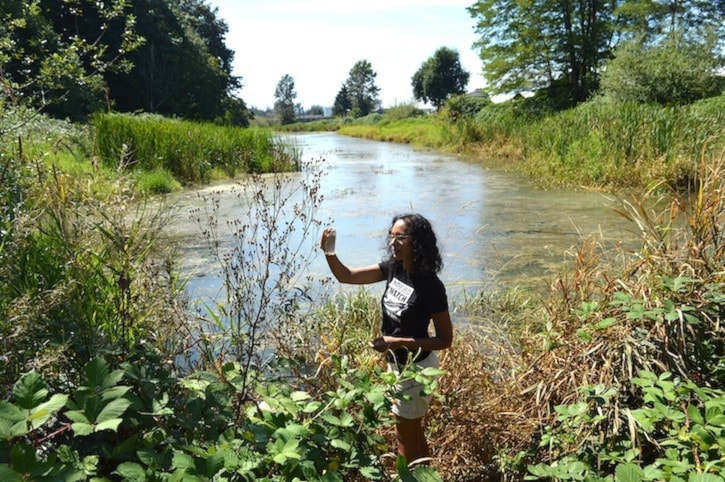It's all about increasing water quality and flow to the local slough to restore salmon habitat in Chilliwack.
Urbanization and agriculture has almost destroyed the once stellar fish habitat over the years, but diking infrastructure also has a role to play.
Lina Azeez, community engagement coordinator with Watershed Watch Salmon Society, invited The Progress and members of the Save Our Slough group for an up-close look at the Camp slough system last Friday.
Azeez joined forces with Save Our Slough founders Roxanne Froese and Lincoln Froese, to raise awareness about the Aug. 18 open house hosted by City of Chilliwack on the Camp Slough Flow Enhancement Project.
The mom-and-son team of Roxanna and Lincoln were the ones who came before council at city hall back in February to ask council during their budget discussions to put funding aside to restore the Hope slough to its former glory.
Attending the Camp Slough consultation later this week is especially crucial for interested residents now that the slough has just experienced a sudden fish die-off and algae bloom, Roxanna Froese said. City officials said a low oxygen plume was to blame for the fish kill seen in the Hope Slough at near the bridge in Kinsman Park.
The mini-slough tour started at the Camp-Hope Intake Project, (CHIP) which at one point would have brought in fresh water from the Fraser River at the easternmost end of the Camp-Hope slough system, and moved west.
"This is a really good example of how flood infrastructure, that was created years ago, has impacted migration patterns and routes for salmonids," said Azeez about the CHIP site.
Water no longer enters the slough that way anymore, and the intake is covered with massive boulders.
"In the past the fish would come through here," said Azeez. "They no longer have access."
They are interested in how dike infrastructure like that has affected habitat and fish rearing areas, and what it could potentially look like in the future.
"We often look at these structures in terms of flood management, but when looking at it solely out of that lens, we are not considering the other uses and fish habitat potential of the side channels and tributaries."
Chinook, for example have a huge problem when they can't access these waterways, she said.
The Connected Waters campaign by Watershed Watch is geared to improving habitat and bringing wild salmon back to the Lower Fraser.
 They created a Connected Waters map of the 450 to 500 flood structures with an eye to "restoring connectivity and function" to the sloughs and channels that function as fish habitat.
They created a Connected Waters map of the 450 to 500 flood structures with an eye to "restoring connectivity and function" to the sloughs and channels that function as fish habitat.
In their sights are the varied flood management structures like flood boxes and gates, mapped out along the vast expanse of the Lower Fraser, and known to impact passage through the various migratory routes.
They encourage upgrades with more fish-friendly structures.
Roxanna Froese, along with her eight-year-old son Lincoln, trouped along the mini-tour of the Camp Slough system, checking out water quality and the presence of fish, and aquatic insects.
Froese wants to spread the word to the public about the consultation and open house event at Camp River Hall on Aug. 18 to discuss the Camp Slough Enhancement Project.
"Given the condition of the slough and the problems it is facing, we encourage people to come to the meeting to say what's important to them about the slough."
Residents have told city hall repeatedly they would like to see the Camp-Hope slough system cleaned up of all the weeds and canary grass overgrowth, and made usable for recreation.
"Hopefully the City will respond with a plan to save the slough," said Froese.
There are still some healthy areas in the Camp Slough, and they see improvement as a long term project.
"Responding now, as opposed to in 10 years from now can prevent it from deteriorating further."
Her dream is to see reintroduction of a fresh water supply to the slough system, that would make it safe for recreation and high quality fish habitat.
* The Camp Slough Flow Enhancement Project is the focus of the public consultation/open house at Camp River Community Hall, August 18, from 6 p.m. to 8 p.m. The hall is at 50246 Camp River Road.
